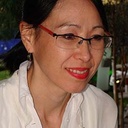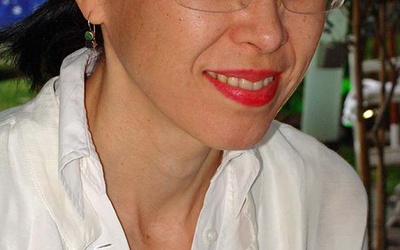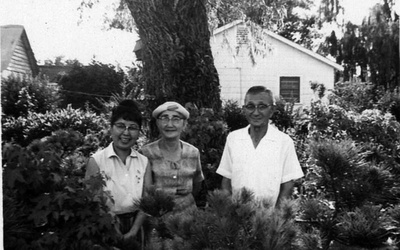
アナ・K・スタール
(Anna K. Stahl)
アンナ・K・スタールは、白人と日本人のハーフである混血夫婦、スタール夫妻の娘です。アンナは、アルゼンチンのブエノスアイレスを拠点にスペイン語で執筆活動を行うフィクション作家、文学/作文教授です。彼女のフィクションや分析エッセイは、異文化体験を探求することが多く、彼女の作品はスペイン語でこのテーマを語る新しい表現として知られています。彼女は南米人と結婚しており、2人の間には多文化のダイナミクスを継続 (そして拡大) する幼い娘がいます。
2012年4月更新
この執筆者によるストーリー
Asian American Literature Forum Response by Anna Kazumi Stahl - Part 3
2012年7月15日 • アナ・K・スタール
Read part 2 >> Now, to return to the issue posed in this forum’s prompt: in my case, I must try to find an instance in which both a generational difference and a national-cultural one revealed their criteria and influence. And there was a specific instance, an event I participated in several years ago, in 2004, for the “Japan Theme Day” at the Buenos Aires International Book Fair. I was invited together with an Argentine Nisei, Maximiliano Matayoshi, a talented young …
Asian American Literature Forum Response by Anna Kazumi Stahl - Part 2
2012年7月8日 • アナ・K・スタール
Asian American Literature Forum Response by Anna Kazumi Stahl - Part 1
2012年7月1日 • アナ・K・スタール
“Are there any continuities,” wonders scholar Min Hyoung Song, “between the earlier generation of writers which first raised the banner of an Asian American literature and a later generation of writers which inherited it?” The Asian American Literary Review asked writers to respond to this question for their Spring 2012 issue on “Generations.” Forum Response by Anna Kazumi Stahl Given that I was born to a mixed race couple (Japanese and German) in the Deep South in 1963, I grew …
The Cajun Nikkei - Part 5 of 5
2012年5月8日 • ミドリ・エナリ , アナ・K・スタール
Read Part 4 >>Stahl Family:The Stahl family was one of the few families in the community that was of mixed race. Mr. Stahl, Earl, was a native of northern Louisiana, from rural areas around Shreveport. He was relatively typical for the region, the grandson of European farming immigrants-in his case from Germany-who had come to the US at the turn of the century in search of better opportunities. The unusual thing about Earl Stahl was that, as a young architecture …
The Cajun Nikkei - Part 4 of 5
2012年5月1日 • ミドリ・エナリ , アナ・K・スタール
Read Part 3 >> Tamai family:Until the 1990s, there was only one Japanese market in the Greater New Orleans area, and that was Oriental Merchandise. It served as an informal social gathering place for the Nikkei of New Orleans. Frank Tamai and George Hirabayashi ran the import/wholesale business originally called Oriental Trading. While the main business was selling Asian goods to retailers, as well as Mardi Gras throws to krewe members, off to one side was a barely noticeable door …
The Cajun Nikkei - Part 3 of 5
2012年4月24日 • ミドリ・エナリ , アナ・K・スタール
Read Part 2 >>Izumi family:Like the Yenaris, the Izumis were interned in Rohwer and were one of the last families to leave camp. Mr. Izumi was in the newspaper business and could not find work after the war had ended. With few options, he moved his family to New Orleans. Eventually, Mr. Izumi met a man named C. D. Hoi, a Chinese businessman who hired him to sell shrimp.1 Although neither spoke the other's language, they communicated by writing everything in …
The Cajun Nikkei - Part 2 of 5
2012年4月17日 • ミドリ・エナリ , アナ・K・スタール
Read Part 1 >>In the oral history tradition, here are some stories from some of the Nikkei’s families in Louisiana:Imahara family:A native of Watsonville, California, Nisei James Imahara was a successful Nikkei farmer who raised strawberries and fruit trees in Sacramento. He married Haruka Sunada, a Kibei Nisei and had nine children. Along with other Japanese Americans, the Imaharas were interned in Arkansas, and Mr. Imahara lost his entire life's efforts. After the War, the Imaharas moved to New Orleans. Although …
The Cajun Nikkei - Part 1 of 5
2012年4月10日 • ミドリ・エナリ , アナ・K・スタール
Japanese and Japanese Americans are certainly a minority in Louisiana, but are nevertheless a viable and tight-knit community. Numbering in the hundreds, families generally lived peacefully next to their non-Japanese neighbors, and joined together during special occasions such as New Year's or Children's Day. Even during difficult times, families would help one another both financially and emotionally. In contrast to the Nikkei of the West Coast, they rarely encountered discrimination even during the post-War years when they tried to piece …









